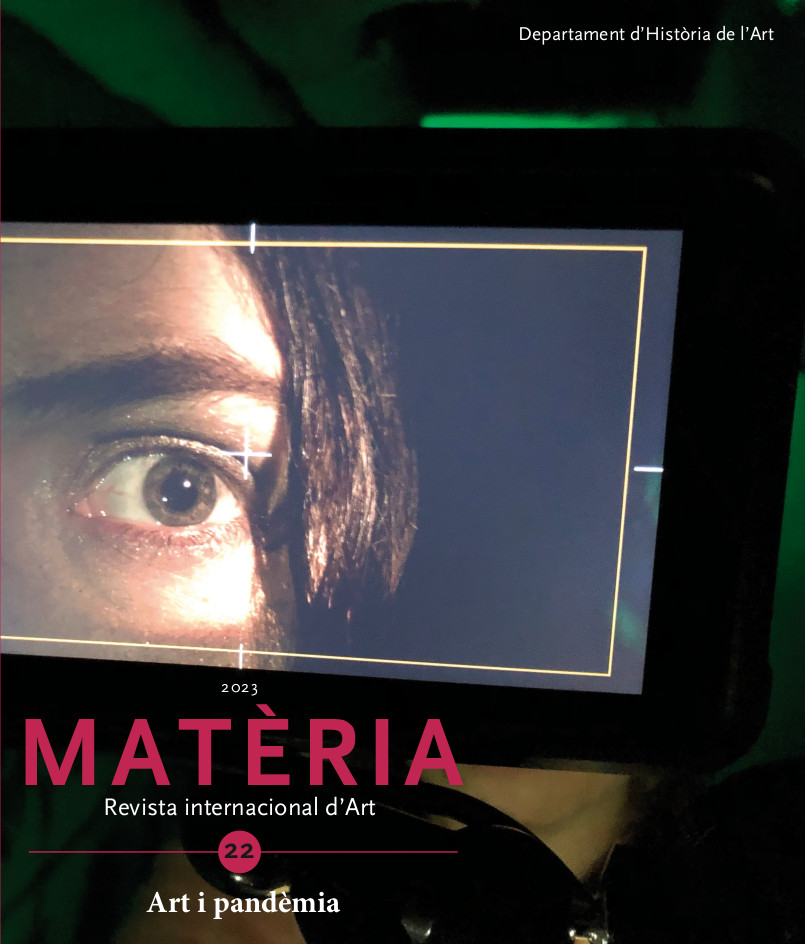Viral Devices: Questioning the relationship between body and space starting from artistic speculation
DOI:
https://doi.org/10.1344/Materia2023.22.6Keywords:
technical hybridization, connected bodies, connected spaces, hyperconnected, proxemics, onlife, hybrid-subjectivities, online-offline spheres, devices, viral, pandemicAbstract
Viral Devices: Questioning the relationship between body and space starting from artistic speculation describes the artistic research process Viral Devices in which the concept of connected bodies and spaces, and the creation of experimental individual and collective spaces come into play with the aim of establishing a collection of situated memories about the possible changes in subjectivities and relationships resulting from the Covid-19 crisis and the increasing merging of online and offline life. Through artistic projects and bibliographic research, we attended the focus of the artistic practice: the testing of several techno-affective devices designed for this project in the wake of the «probe objects» in order to observe, relate and open up new possible experiences in the face of a patent paradigm shift.
References
AGAMBEN, Giorgio, ¿Qué es un dispositivo?, seguido de El amigo y La Iglesia y el Reino, Buenos Aires, Adriana Hidalgo, 2014 (Roma, 2006)
AGAMBEN, Giorgio, Profanaciones, Buenos Aires, Adriana Hidalgo, 2005
BERARDI, Fanco “Bifo”, Crónica de la psicodeflación en Sopa de Wuhan. Pensamiento Contemporáneo en Tiempos de Pandemias, ASPO (Aislamiento Social Preventivo y Obligatorio), 2020
BOEHNER, Kirsten, GAVER,William, y BOUCHER, Andy, «Probes», en C. Lury & N.Wakeford (Eds.), Inventive Methods: The Happening of the Social, Londres, Routledge, 2012, p. 185-201
BOSERMAN, Carla, «Rescuing Epistemic Objects from Speculative Design», Diseña, vol. 14, 2019, p.118-137. Doi: https://doi.org/10.7764/disena.14.118-137
BUTLER, Judith, El capitalismo tiene sus límites en Sopa de Wuhan. Pensamiento Contemporáneo en Tiempos de Pandemias, ASPO (Aislamiento Social Preventivo y Obligatorio), 2020, p. 59-65
COLOMINA, Beatriz y WIGLEY, Mark, ¿Somos humanos? Notas sobre una arqueología del diseño, Ciudad de México, Arquine, 2021 (Zurich, 2016)
CONTROL WARS.(s.f) Control Wars Laboratorio. https://controlwars.org/
COOK, Terry y SCHWARTZ, Joan M., «Arxius, registres i poder: de la teoria (postmoderna) a la performance (arxivística)», Arxivar, Barcelona, Ajuntament de Barcelona, Institut de Cultura, La Virreina Centre de la Imatge, 2017, p. 19-51
DELEUZE, Gilles, «¿Qué es un dispositivo?» en Michel Foucault, filósofo, Barcelona, Gedisa, 1989, p. 155-163
DUNNE, Anthony, y RABY, Fiona, Speculative everything: design, fiction, and social dreaming, Cambridge, Massachusetts, The MIT Press, 2013
FOUCAULT, Michel, Dits et écrits 1954-1988, Vol. 3, D. Defert e F Ewald, Editions Gallimard, Paris, 1994
FLORIDI, Luciano, GANASCIA, Jean-Gabriel, ESS, Charles, BROADBENT, Stefana, LOBET-MARIS, Claire, YIANNIS, Laouris, SIMON, Judith, UGO, Pagallo, et al., The onlife manifesto, New York, Springer, 2014
FLUSSER, Vilém, Los gestos: fenomenología y comunicación, Barcelona, Herder, 1994
GROYS Boris, «The Obligation to Self Design» [en línia], E-Flux Journal, 00, 2018, disponible en https://www.e-flux.com/journal/00/68457/the-obligation-to-self-design/ [consulta: 8-12-2022]
HALL, Edward, La dimensión oculta: un enfoque antropológico del uso del espacio, Madrid, Nuevo Urbanismo, 1973
HESS, Amanda, «The Credibility Bookcase is the Quarantine’s Hottest Accessory» [en línia], The New York Times, 2020, disponible en https://www.nytimes.com/2020/05/01/arts/quarantine-bookcase-coronavirus.html [consulta: 12-12-2022]
JAQUE, Andrés y Office for Political Innovation (eds.), Políticas transmateriales: Transmaterial politics, Madrid, Ministerio de Educación, Cultura y Deporte, 2017
JAQUE, Andrés, Mies y la gata Niebla: ensayos sobre arquitectura y cosmopolítica, Barcelona, Puente Editores, 2019
KETELAAR, Erik, «Compartir; memòries recopilades en comunitats de registres», Arxivar, Barcelona, Ajuntament de Barcelona, Institut de Cultura, La Virreina Centre de la Imatge, 2017, p.53-78
LATOUR, Bruno, Reensamblar lo social una introducción a la teoría del actor-red, Buenos Aires, Manantial, 2008
MANOVICH, Lev, Cultural analytics, Cambridge, Massachusetts, The MIT Press, 2020
MARZO, Jorge Luis, RISPOLI, Ramon, «Editorial», Inmaterial. Diseño, Arte y Sociedad, vol. 6 (12), 2021, p. 4-12
MC MANSION HELL, «Coronogrifting: A Design Phenomenon» [en línia], Mc Mansion Hell, 2020, disponible en https://mcmansionhell.com/post/618938984050147328/coronagrifting-a-design-phenomenon [consulta: 11-12-2021]
PAUL, Christiane, «From Immateriality to Neomaterality: Art and the Conditions of Digital Materiality», ISEA2015, Proceedings of the 21st International Symposium on Electronic Art, 2015
PRADA, Juan Martín, «Towards a Theory of Social Media Art» en Art, Images and Network Culture, Sevilla, Aula Magna, Proyecto Clave, McGraw Hill, 2021
PUIG PUNYET, Enric, Los cuerpos rotos. La digitalización de la vida tras la covid-19, Madrid, Clave Intelectual, 2020
RANCIÈRE, Jacques, El reparto de lo sensible, Buenos Aires, Prometeo Libros, 2014
SCOLARI, Carlos, Las leyes de la interfaz: diseño, ecología, evolución, tecnología, Barcelona, Gedisa Editorial, 2018
PINHEIRO, Daniel «When online goes viral» [en línea], Daniel Pinheiro, 2020, disponible en: https://daniel-pinheiro.tumblr.com/onlinegoesviral
SIBILIA, Paula, El hombre postorgánico. Cuerpo, subjetividad y tecnologías digitales, Ciudad de México, Fondo de Cultura Económica, 2012
SL SECOND LIFE, Second Life: Virtual Worlds, Virtual Reality, VR, 2003, disponible en https://secondlife.com/
ZAFRA, Remedios, Un cuarto propio conectado, (Ciber)espacio y (auto)gestión del yo
Madrid, Fórcola Ediciones, 2010
ZAFRA, Remedios, Ojos y capital, Bilbao, Consonni, 2018
ZAFRA, Remedios, Frágiles, Barcelona, Panorama, 2021
WAJCMAN, Judy, El Tecnofeminismo, Valencia, Ediciones Cátedra, 2006
Downloads
Published
Issue
Section
License
Copyright (c) 2023 Citlali Hernández Sanchez, Silvia Bernad Lage, Núria Nia, Giorgia Scavo

This work is licensed under a Creative Commons Attribution-NonCommercial-NoDerivatives 4.0 International License.
The authors who publish in this journal agree to the following terms:
|  |







